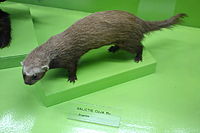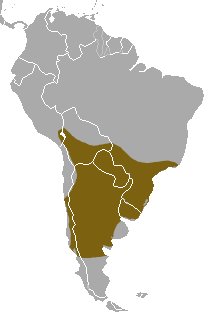Lesser grison
| Lesser grison | |
|---|---|
 |
|
| Scientific classification | |
| Kingdom: | Animalia |
| Phylum: | Chordata |
| Class: | Mammalia |
| Order: | Carnivora |
| Family: | Mustelidae |
| Genus: | Galictis |
| Species: | G. cuja |
| Binomial name | |
|
Galictis cuja (Molina, 1782) |
|
 |
|
| Lesser grison range | |
The lesser grison (Galictis cuja) is a species of mustelid from South America.
Lesser grisons have a long, slender body, short legs, and a bushy tail. They have a long neck and a small head with a flattened forehead and rounded ears. They are smaller than the closely related greater grison, with a head-body length of 27 to 52 cm (11 to 20 in) and a tail 14 to 19 cm (5.5 to 7.5 in) long. Adults weigh anything from 1.2 to 2.4 kg (2.6 to 5.3 lb). Females are slighter smaller and more slender than males.
The top of the head, the back and flanks, and the tail have coarse black guard hairs with buff-coloured tips over a softer undercoat, giving them a grizzled greyish colour. The remainder of the body is black or nearly so, apart from a pale buff-coloured stripe running from the forehead to the shoulders along the lower margin of the grey furred area. The feet are webbed, with five toes ending in sharp, curved, claws.
Lesser grisons are found throughout most of southern South America from sea level to as high as 4,200 metres (13,800 ft) elevation. They are found in a wide range of habitats, although generally near water, including grasslands, forests, scrub, and mountain meadows. They are also known to inhabit agricultural land and pasture in some areas.
Four subspecies are recognised:
Lesser grisons are carnivorous, feeding on small to medium rodents, as well as rabbits, birds, frogs, lizards, and snakes. They are among the major predators on cavies, including wild guinea pigs, and also of nesting grebes.
They are semi-plantigrade, walking partly on the soles of their feet, and, despite the webbing, their feet are adapted more for running and climbing than for swimming. They possess anal scent glands that spray a noxious chemical similar to, but probably weaker than, that of skunks. They are monogamous, hunting together when raising their litters of two to five young.
Lesser grisons hunt primarily during the day, locating their prey at least partly by scent. They are either solitary, or live in small family groups of parents and offspring, which travel together in single file. They are said to be particularly fierce, and to play with their food for up to 45 minutes before eating it. During the night, they sleep in hollow trees or natural crevices, or else in excavated burrows. Burrows may be as deep as 4 m (13 ft), and have entrances obscured by leaves.
...
Wikipedia

